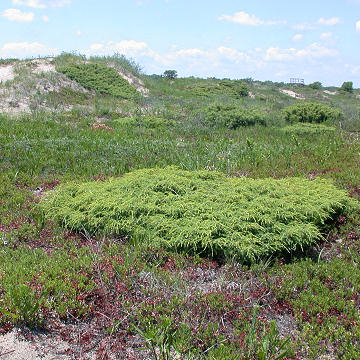

Juniperus communis - (image 1 of 6)
Taxonomy
Family: Cupressaceae
Habitat
Sandy soils, dunes, clayey slopes,. Shade intolerant.
Associates
Found on foredunes of Lake Michigan with Andropogon scoparius, Arabis lyrata, Artemesia caudata, Lithospermum croceum, Prunus pumila, Solidago racemosa gillmanii. Further from the lake is also found with Arctostaphylos uva-ursi, Celastrus scandens, Cornus stolonifera, Pinus banksiana, Prunus virginiana, Ptelea trifoliata mollis, Smilacina stellata, Vitis riparia.
Distribution
Found in northern zones of Europe, Asia, the Middle East and the United States and Canada. In the eastern US it is found from New England to PA and NC.
Morphology
Highly variable shape, from tree-form to prostrate groundcover. Leaves awl-shaped, persisting for 3 years, sharply pointed, sessile, spreading at a wide angle from the stem, with a broad wide band above, occurring in threes. Bark reddish brown, peeling of in papery sheets. Flowers dioecious; staminate flowers yellow. Fruit a fleshy, berry-like cone, blue or blue-black with a waxy bloom; ripening in the second or third year; seeds usually 3.
Notes
Flowers late April to early June
Wetland indicator: Facultative Upland
An attractive shrub with an almost cascading branching habit. Overall shape varies from one plant to the next, ranging from rounded to vase-shaped to flat as a pancake. Summer color is a rich green; in winter it turns rather brownish-purple, making up part of the patchwork of dull greens, browns, and purples that liven up the dune landscape in winter.
References
Dirr, Michael A. 1998. Manual of Woody Landscape Plants:
Their Identification, Ornamental Characteristics, Culture, Propagation and Uses.
5th ed. Champaign, Illinois: Stipes Publishing L.L.C.
Swink, F. and G. Wilhelm. 1994. Plants of the Chicago Region.
Indiana Academy of Science. The Morton Arboretum. Lisle, Illinois.
|
Michael Hough © 2005 |